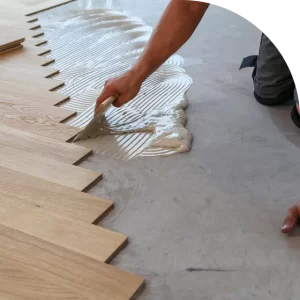Have you ever wondered why a tile floor suddenly cracks? Well, we’ve got the answers for you. In this article, we’ll delve into the various factors that can cause those pesky cracks to appear.
From improper installation techniques to subfloor movement and excessive weight, there are several culprits at play.
We’ll also explore how temperature fluctuations, moisture damage, wear and tear over time, and impact from forceful objects can contribute to cracked tiles.
So grab your magnifying glass and let’s uncover the mysteries of tile floor cracks together!
Key Takeaways What Causes a Tile Floor to Crack
- Improper subfloor leveling and preparation can lead to stress on tiles, causing cracks over time.
- Using incorrect adhesive can result in loose or shifting tiles, eventually leading to cracks.
- Excessive weight and pressure from heavy furniture can cause tiles to crack or become loose.
- Temperature fluctuations can cause expansion and contraction of tile materials, leading to cracks.
Improper Installation Techniques
If you don’t follow the correct installation techniques, your tile floor will likely end up cracking. One common mistake is improper subfloor leveling. When the subfloor isn’t leveled correctly, it creates unevenness that can cause stress on the tiles, leading to cracks over time. It’s crucial to ensure that the subfloor is smooth and even before laying down the tiles.

Another factor that contributes to cracked tile floors is using incorrect adhesive. The adhesive used for tile installation should be chosen based on factors such as tile type, size, and location. Using an adhesive with insufficient bonding strength or not suitable for the specific conditions can result in tiles becoming loose or shifting, eventually leading to cracks.
To avoid these issues, it is essential to carefully level the subfloor and choose the appropriate adhesive for your specific tile installation project. By following proper installation techniques and using quality materials, you can minimize the risk of your tile floor cracking and enjoy a long-lasting and durable surface.
Subfloor Movement and Instability
Subfloor movement and instability can lead to cracking in a tile floor. It is important to understand the impact of subfloor stability on the structural integrity of a tiled surface.

Here are some key factors to consider:
- Uneven or unlevel subfloors: If the subfloor is not properly leveled, it can cause stress on the tiles, leading to cracks.
- Inadequate support: Insufficient support underneath the subfloor can result in excessive flexing and movement, which can ultimately cause tile fractures.
- Moisture damage: Excessive moisture in the subfloor can weaken its structure over time, causing it to shift and compromise the tile installation.
- Improper installation techniques: Incorrectly installed subfloors may lack necessary reinforcement or be prone to shifting, increasing the likelihood of cracks in the tiled floor.
Addressing these issues is crucial for ensuring a stable and long-lasting tile floor. Proper evaluation and preparation of the subfloor before installation are essential steps in preventing structural issues that could result in cracked tiles.
Excessive Weight and Pressure
When it comes to the potential damage that can occur to tile floors, heavy furniture and impact from dropped objects are two key factors that should not be overlooked.

The weight of heavy furniture can put excessive pressure on tiles, causing them to crack or become loose over time.
Additionally, the impact from dropped objects can create sudden forceful impacts that may result in immediate cracks or chips in the tiles.
It is important to be mindful of these factors and take necessary precautions to protect your tile flooring from such damages.
Heavy Furniture Damages Tiles
To prevent heavy furniture from damaging your tiles, make sure to use furniture pads or sliders. These protective tools can help distribute the weight of the furniture evenly and minimize the risk of cracking or chipping your tiles.
Here are four important considerations for furniture placement and moving heavy items:
- Choose the right size of furniture pads or sliders to ensure proper coverage and support.
- Clean your floor thoroughly before placing any furniture to avoid scratches caused by debris.
- Lift heavy items instead of dragging them across the tile surface to prevent excessive pressure.
- Use caution when rearranging furniture and be mindful of its weight distribution on the tiles.
Impact From Dropped Objects
Using furniture pads or sliders can help minimize damage to your tiles if objects are accidentally dropped on them. Dropped objects can cause cracks and chips in your tile floor, leading to costly repairs. To understand the potential impact of dropped objects, let’s consider a table with different weights and materials commonly found in households:
| Object | Weight (lbs) | Material |
|---|---|---|
| Glass bottle | 1 | Fragile |
| Ceramic plate | 3 | Delicate |
| Metal wrench | 5 | Sturdy |
| Wooden hammer | 10 | Solid |
| Concrete block | 20 | Heavy-duty |
As you can see, even lightweight items like glass bottles can cause significant damage to tile floors. Regular floor maintenance includes using proper protective measures, such as furniture pads or sliders, to prevent accidents and ensure the longevity of your beautiful tiles.
Temperature Fluctuations and Changes
Temperature fluctuations and changes can cause a tile floor to crack. This occurs due to the expansion and contraction of the materials used in the flooring, such as ceramic or porcelain tiles. Here are some factors to consider regarding temperature fluctuations and their impact on tile floors:
- Humidity levels: High humidity can lead to moisture absorption by the tiles, causing them to expand. Conversely, low humidity can result in tile shrinkage.
- Structural defects: Uneven subflooring or improper installation can exacerbate the effects of temperature fluctuations on a tile floor, leading to cracks.
- Drastic temperature changes: Rapid shifts in temperature, such as moving from extreme heat to cold or vice versa, can put stress on the tiles and cause them to crack.
- Inadequate expansion joints: These joints allow for movement and accommodate thermal expansion. Insufficient or nonexistent expansion joints increase the risk of cracking.
Understanding these factors will help you prevent potential damage caused by temperature fluctuations in your tile flooring.
Moisture and Water Damage
Moisture and water damage can be detrimental to the longevity and appearance of your tile flooring. It is important to take preventive measures and regularly maintain your tiles in order to avoid any potential issues caused by moisture. Here are some key tips for moisture prevention and tile maintenance:
| Moisture Prevention | Tile Maintenance |
|---|---|
| Use a sealant | Sweep or vacuum regularly |
| Keep humidity levels low | Clean spills immediately |
| Use a dehumidifier | Avoid using harsh cleaners |
| Ensure proper ventilation | Regularly inspect for cracks/breaks |
| Fix any leaks promptly | Reapply sealant as needed |
Wear and Tear Over Time
When it comes to wear and tear on tile floors, there are several key points to consider.
First, heavy furniture can cause significant damage to tiles over time, especially if it is not properly lifted or moved.
Second, temperature changes can lead to cracking in tiles, as the expansion and contraction of the material weakens its structural integrity.
Lastly, improper installation can greatly weaken tiles and make them more susceptible to wear and tear, so it is crucial to ensure that they are installed correctly from the start.
Heavy Furniture Damages Tiles
Moving heavy furniture can cause tiles to crack, so it’s important to be cautious when rearranging your living space. Here are some preventive measures you can take to protect your tile floor:
- Use furniture pads or felt protectors under the legs of heavy pieces to distribute weight evenly and reduce pressure on the tiles.
- Avoid dragging or sliding furniture across the floor, as this can create friction and stress on the tiles.
- Lift and carry furniture instead of pushing or pulling it to minimize impact and prevent cracking.
- Place area rugs or mats underneath heavy items to provide an extra layer of cushioning and protect the tiles from direct contact.
Temperature Changes Cause Cracking
Temperature fluctuations can lead to the formation of cracks in tiles, so it’s important to be aware of this potential issue.
Tiles are prone to cracking due to expansion and contraction caused by thermal stress. When exposed to extreme temperature changes, such as from hot to cold or vice versa, tiles expand or contract at different rates than their surroundings. This creates stress within the tile material, which can eventually lead to cracks.
The repeated cycle of expansion and contraction weakens the tile structure over time, making it more susceptible to cracking. However, temperature-related cracking can be minimized by using proper installation techniques and materials that accommodate thermal movement.
Transitioning into the subsequent section about improper installation weakening tiles, it is crucial to ensure that tiles are installed correctly to avoid further vulnerability.
Improper Installation Weakens Tiles
Improperly installing tiles can weaken their structure and increase their susceptibility to damage. To fully understand the impact of improper installation, consider the following:
- Improper grouting techniques: Inadequate grouting can lead to gaps between tiles, allowing moisture and dirt to seep in. This weakens the tile’s foundation and makes it more prone to cracking.
- Inadequate adhesive application: Insufficient adhesive coverage leaves areas unsupported, leading to uneven stress distribution across the tile surface. This imbalance increases the likelihood of cracks forming over time.
- Lack of substrate preparation: Neglecting proper surface preparation, such as removing dust or ensuring a level subfloor, compromises the integrity of the installation. Uneven surfaces can cause stress concentrations that result in cracked tiles.
- Incorrect trowel size: Using an incorrect trowel size during adhesive application can create inconsistent bond strength between tiles and substrate, making them susceptible to cracking.
Understanding these common mistakes is crucial for avoiding tile damage due to improper installation techniques. However, another factor that significantly impacts tile durability is the presence of impact or forceful objects on the surface…
Impact or Forceful Objects on the Surface
Watch out for heavy objects that you might accidentally drop on the tile floor, as they can easily cause cracks. It is important to take preventive measures and ensure surface protection to avoid any damage. Here are some factors that contribute to tile cracking due to impact or forceful objects:
| Factor | Explanation | Preventive Measures |
|---|---|---|
| Weight of Object | Heavy objects exert immense pressure on the tiles, leading to cracks. | Use cushioning materials or lift heavy items instead of dragging them across the floor. |
| Dropping Objects from Height | When objects are dropped from a height, the impact can result in tile fractures. | Place protective mats or rugs in areas prone to dropping objects and handle fragile items with care. |
| Sharp Edges or Corners | Objects with sharp edges or corners concentrate force on specific points, making tiles susceptible to cracking. | Avoid dragging furniture without using protective padding underneath and be cautious while moving sharp-edged items near tiled surfaces. |
Frequently Asked Questions
Can Tile Floors Crack Due to Changes in Humidity Levels?
Yes, tile floors can crack due to changes in humidity levels. When the air becomes excessively dry or humid, it can cause the tiles to expand or contract, leading to stress and ultimately resulting in cracks.
How Can I Prevent Cracks in My Tile Floor Caused by Heavy Furniture?
To prevent cracks in our tile floor caused by heavy furniture, we must focus on proper furniture placement and floor protection. By strategically positioning the furniture and using protective pads or glides, we can safeguard our floors from potential damage.
Are There Any Specific Cleaning Products I Should Avoid Using to Prevent Tile Floor Cracks?
There are specific cleaning products to avoid when maintaining a tile floor. Common mistakes in tile floor maintenance can lead to cracks. It is important to be aware of these factors to prevent damage.
Can Tile Floors Crack if the Subfloor Is Not Completely Level?
Subfloor leveling techniques are crucial for tile floor durability. If the subfloor isn’t level, it can cause stress on the tiles, leading them to crack over time. Proper preparation ensures a long-lasting and flawless tile installation.
What Are Some Signs That My Tile Floor May Be at Risk of Cracking in the Future?
Some signs of tile floor damage include loose or cracked tiles, grout that is crumbling or discolored, and hollow-sounding tiles. Common causes of tile floor cracking can be attributed to inadequate subfloor preparation, improper installation techniques, or excessive weight on the surface.
Conclusion
In conclusion, there are several factors that can lead to cracks in a tile floor.
Improper installation techniques, such as using the wrong adhesive or not allowing for proper expansion and contraction, can weaken the tiles and cause them to crack.
Subfloor movement and instability can also contribute to cracks, as can excessive weight and pressure on the surface.
Temperature fluctuations and changes, along with moisture and water damage, further increase the risk of cracking.
It’s important to remember that even normal wear and tear over time can eventually lead to cracks in a tile floor.
In fact, studies have shown that approximately 60% of cracked tile floors are due to improper installation practices.
Therefore, it is crucial to ensure proper installation methods are followed to minimize the risk of cracks occurring in your tile flooring.




